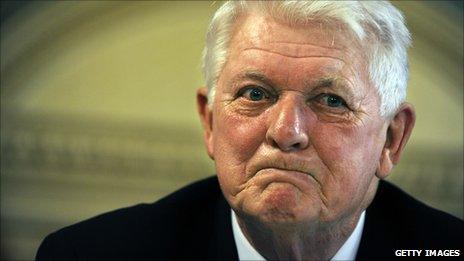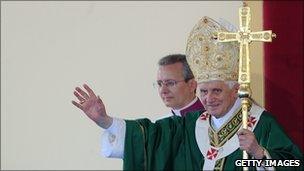Papal visit: Cardinal Newman's 'miracle cure'
- Published

Deacon Jack Sullivan says he is simply the 'recipient of a tremendous divine favour'
Jack Sullivan was in agony. Bedridden after complicated surgery on his spine, the pain was so intense he was unable to sleep and had trouble breathing.
An earlier scan had revealed the vertebrae in his lower back had turned inwards and were squeezing his spinal cord, severing the protective layer around the spine. His doctor said the case was one of the worst he had ever seen and that he was lucky not to have been paralysed.
Nearly a decade later, on Sunday the 71-year-old will walk pain-free to preach the Gospel at the Mass to beatify the 19th Century Cardinal John Henry Newman.
The open-air beatification Mass in Birmingham's Cofton Park is the centrepiece of Pope Benedict XVI's four-day UK visit.
Hundreds of priests, bishops and cardinals will celebrate it, some 50,000 worshippers are expected to attend, and millions more will be following the proceedings on television.
To be beatified - or made blessed, the penultimate step on the path to full sainthood - an individual's worthiness must be proven by the attribution of a miracle following a petition by someone in need.
Critics say miracles - unexpected events attributed to divine intervention - have no place in the world of modern medicine, and are more likely the result of a placebo effect, or wishful thinking, than divine intervention.
But after eight years of investigation by a Vatican panel of medical experts, Jack Sullivan's 2001 healing was last year confirmed by the Pope as miraculous.
Miracle or modern medicine?
Jack Sullivan had just completed the second year of a four-year course to become a deacon - the level of Catholic ministry below priesthood - when he was struck by crippling back pain in 2000.
Doctors warned he would have to quit his religious studies to undergo surgery, and the former court official returned home dejected, flicking through television channels until he came upon a programme about Cardinal Newman.
It ended with an appeal for anyone who had received a "divine favour" after praying to Cardinal Newman to get in touch.
"I certainly needed a divine favour at that moment so I prayed: 'Please Cardinal Newman help me to walk so that I can return to classes and be ordained'," said Mr Sullivan.
When he woke the next morning, the pain had gone, he told the BBC, allowing him to complete his third year of classes before it returned, on the final day of the academic year.
Orthopaedic surgeon Dr Robert Banco explained the back and leg pain was due to severe stenosis, or compression of the spinal cord and nerves.
The Boston doctor later told Vatican investigators it was "a miracle itself" his patient had been able to walk pain-free, let alone complete his religious studies, during the previous nine months.
He recommended a laminectomy to remove a part of the spinal bones that was causing the problem.
Although successfully performed in August 2001, this operation left Mr Sullivan in immense pain and he was warned a full recovery might take months.
Sceptical experts
With the new term approaching, Mr Sullivan was becoming increasingly anxious about returning to class, and just a few days after his operation he tried to get out of bed.
Having taken an excruciating few minutes, with a nurse's help, to get his feet to the floor, he said he leant on his forearms and recited his prayer to Newman.
"Suddenly I felt an intense heat, like an oven blast, and a strong tingling sensation throughout my whole body," he said. "I felt an indescribable sense of joy and peace, and was totally transfixed by what I believed to be God's presence.
"When I became aware of what was happening around me I was standing upright and I exclaimed to the nurse that I felt no more pain."
Dr Banco, a Catholic, has testified the recovery was "unbelievable, 100%, totally remarkable... I have never seen a healing process occur so quickly and completely."
But Newman's biographer, John Cornwell, cites other medical experts who are less surprised by the swift recovery.
Michael Powell, a consultant neurosurgeon at London's University College Hospital, said a typical laminectomy took "about 40 minutes, and most patients... walk out happy at two days".
Mr Cornwell even quotes the scepticism of Newman himself on miracles, arguing that the faithful should be prepared to accept they occur within, rather than outside, nature.
Divine favour?
Jack Sullivan is unfazed by sceptics. Convinced his healing was the result of his prayer, he penned a letter to the Birmingham Oratory, which Newman had founded in 1848, setting in motion the lengthy process that will culminate in the 19th Century cleric's beatification.

The beatification will be the first Benedict XVI has overseen as Pope
That Benedict XVI is to oversee the beatification demonstrates the esteem in which he holds the man who founded the Oxford Movement to bring the Anglican Church back to its Catholic roots.
Under the Pope's own rules, beatification is normally performed by a senior bishop from the diocese where the candidate for sainthood died.
A prodigious author who was hailed by James Joyce as "the greatest of English prose writers", Newman converted at the age of 44, and was made a cardinal by Pope Leo XIII, before dying in Birmingham in 1890.
Jack Sullivan successfully completed his studies to become a deacon, was ordained in 2002 and his flock these days includes prisoners whom he advises not to give up hope of redemption against adversity.
The married father of three is thrilled to be taking part in the beatification of England's most famous Catholic convert aside, perhaps, from Tony Blair.
"I thought that I'd accomplished everything I wanted in this world simply by being ordained," he said.
"I'm just a recipient of a tremendous divine favour, and am showing my gratitude as best I can to Newman and to God by throwing myself into my ministry."
Former Conservative minister Ann Widdecombe explores Cardinal Newman's road to sainthood in Newman - Saint Or Sinner?, also available on BBC iPlayer.